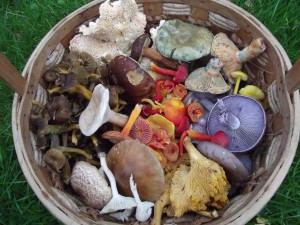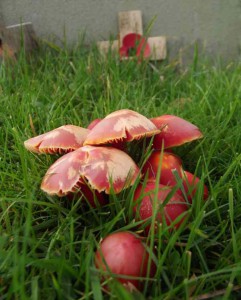Email: geoffdann@hotmail.com
Phone: 07964 569715
11/11/2013
When the days have got shorter and the wind and rain have chased the fair-weather foragers back to their cosy living rooms, when the chanterelles have all been picked and any penny buns still standing are just hollow, grub-filled shells, when the deciduous trees have dropped most of their leaves and the mainstream modern world has turned the central heating on and is looking forward to Christmas…is mushroom season over? Hell, no it isn’t!
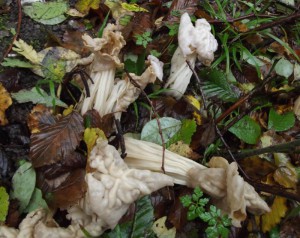
White Saddle (Helvella crispa) having a storming 2013. These usually turn up as singletons, but have been trooping in large numbers this year.
I nearly didn’t post this. I sat in the bath for a while and mulled it over. Do I really want to tell people this? Wouldn’t it be better just to keep quiet about it and post something about what an extraordinary year it has been for the strange, recently-declared-toxic White Saddle (Helvella crispa) instead? But then I concluded that not enough people read my blog to make any significant impact on the greatest fungal bounty the British countryside has to offer, especially since it involves people trudging around in the mud in search of something that most of them probably wouldn’t notice if it was right in front of them. And yet it ranks right up there among the best of the edible wild fungi and in a good year it fruits in such wild abundance that it would take an army of foragers to pick even half of them.
Now that mushroom foraging has really taken off in the UK it is not so easy to find Chanterelles (Cantherellus cibarius). They are, after all, bright yellow-orange and can be spotted from 40 metres if your vision is any good. I mean…there’s not that many brightly coloured objects scattered around on the woodland floor and everybody who has ever taken an interest in wild fungi knows what a chanterelle looks like. Plus they grow when you can still go mushrooming in a T-shirt. Far fewer people ever go looking for their late-season cousins, regardless of the fact that they outnumber the apricot-scented chanterelle by a factor of at least a thousand.
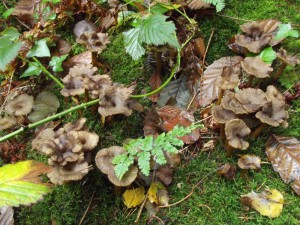
Winter Chanterelle (Craterellus tubaeformis). Early November 2013.
I am talking, of course, about Craterellus tubaeformis, otherwise known as the Winter Chanterelle, Trumpet Chanterelle or Yellowleg (or unhelpfully and confusingly called a Chanterelle, as it is in France, by people who also call Chanterelles by the French name “Girolle”). They are the sort of thing you probably wouldn’t notice at all unless you were looking for them. They are grey-brown, rather ragged and very well camouflaged. They also like to grow under bracken in inaccessible places. However, if you do happen to spot one then you stand a very good chance of finding as many more of them as you have the time and inclination to pick, and that is especially true right now. 2013 has been a vintage year for the whole of the Cantherellaceae family, so it comes as no surprise that it is proving to be a vintage year for C. tubaeformis.
What do you do with them? Well, first you have to take them home and carefully clean them. This requires the removal of the stem bases (if you weren’t sensible/patient enough to do that before you put them in your basket), then the use of a brush or nimble fingers to get rid of pine needles and bits of bracken. You’ll also need to tear open the bigger ones because they tend to accumulate debris and small animals inside their tubular stems. They have a taste which is both strong and delicate. Not overpowering, but enough to impart a lovely flavour to anything you might cook them with which isn’t already overpoweringly strong-tasting. They make a great addition to spaghetti bolognese, but if you want to try something a bit more adventurous then I can heartily recommend the wild mushroom and leek tart posted on our sister site Charmed Pot, which would work perfectly well with 100% Winter Chanterelles, although there are still Hedgehog Mushrooms (Hydnum repandum) about.
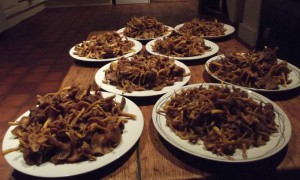
Winter chanterelles in abundance. These were picked on the first day I had a customer fail to turn up for a foraging session. And it was at a location chosen by himself! Bad move.
As for identification problems, there isn’t much you could get these mixed up with. Maybe some of the small milkcaps, which don’t taste nice but won’t do you any harm. They are rather variable, both in size and shape, but they occur in such prodigious numbers that it shouldn’t take you long to familiarise yourself with all the variation they have to offer. All you’ve got to is find that first one.
Provided it doesn’t get really cold (serious frosts) before then, I expect to keep finding this species right through until the end of November and beyond. They will run out of steam before Christmas even if it hasn’t got seriously cold by then.

